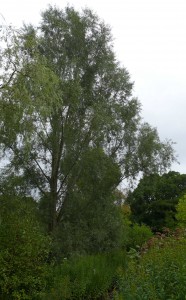Willow – Salix alba (Salicaceae)
Gaelic: seileach
Common Names: White Willow
Willow is native throughout Europe, and western Asia. There are numerous species, many of which are known as willow, with more than a dozen in Scotland. This particular species Salix alba is also known as the white willow, due to the pale green-white colour of the leaves – caused by the fine white silky hairs that are on both the upper and lower surfaces. It can form large trees, up to 30m, and often has a leaning crown. It is wind pollinated and the male and female flowers are born on separate plants (dioecious). The male flowers are often known as ‘pussy willow’ as they form tight furry clusters.
The flexible shoots of the willow are popular for basketry and in the making of creels and lobster pots as they are flexible and can be easily shaped. The wood of one variety, Salix alba var. caerula (the Cricket bat willow) is used for the manufacture of cricket bats, as it was considered to be the best for this purpose. The bark is important in the tanning of animal hides. It is also a traditional treatment for pain and reducing fevers; in the late 19th century an Italian chemist and French pharmacist identified the active component of the bark as salicin, and were able to extract Acetylesalicyclic acid, which now forms the basis of aspirin.


2 Comments
2 Pingbacks